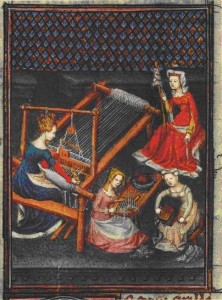Medieval Collaborations
Courtauld Institute Medieval Postgraduate Student Colloquium
The Courtauld Institute of Art, February 04, 2017
Deadline: Nov 25, 2016
 In the earliest days of the discipline, medieval art historians were preoccupied with attempts to name and locate masters in anonymous works through formal analysis. In recent years, however, new approaches have favoured the proposal and identification of collaborative working practices. Recent investigations of collaborations like that of Simone Martini and Lippo Memmi, the illuminators of the Winchester Bible, or the creators of Opus Anglicanum reveal a more complex picture of artistic co-operation.
In the earliest days of the discipline, medieval art historians were preoccupied with attempts to name and locate masters in anonymous works through formal analysis. In recent years, however, new approaches have favoured the proposal and identification of collaborative working practices. Recent investigations of collaborations like that of Simone Martini and Lippo Memmi, the illuminators of the Winchester Bible, or the creators of Opus Anglicanum reveal a more complex picture of artistic co-operation.
Notions of the artist as master have been replaced with those of artists working together, from the collaborative artisan activity in eighth-century cloisters to the increasing specialisation in the twelfth-century shop. Collaborations spanned media, with the erection of stone churches requiring not just the mason’s carving but the carpenter’s scaffolding and centring. The master and apprentice paradigm has slowly been eroded with narratives of apprentices working alongside, subverting, and surpassing their so-called masters.
The Courtauld Institute’s 22nd Annual Medieval Postgraduate Colloquium invites speakers to consider new approaches to artistic collaborations of the Middle Ages, and how conceptions of collaboration have impacted on the study of these works. Applicants are encouraged to consider a wide range of methodologies and subjects in their approach.
Some possible areas might include:
– Collaborators and Co-Creations: how can medieval art and architecture act as evidence of artistic collaboration? Case studies of artworks; seen and unseen collaborations between artist and patron, writer, scribe and illuminator, mason and glazier, master and apprentice, carpenter and painter; collaborations between or within religious orders, church and crown, across countries
– Process and Method: how were collaborative artworks planned and carried out? Collaborative working processes and shared technologies; specialized skills and divisions of labour; contracts and documentary evidence; shop structures vs ad hoc collaborative undertakings; collaborations across media
– Conflict in Collaboration: how were conflicting methods and ideas resolved? Evidence of less-than-seamless cooperation and differing conceptions; reworking by a second collaborator of the first’s work Representation and Reception: how are collaborative projects presented and represented? Signatures, mythologies of the maker as individual, and representations of cooperative working
– Intervention and Adaption: how are initial plans adapted over time? Long-term building/construction projects; later interventions to earlier artworks; ‘collaborations’ spanning time
– Collaborations in Medieval Art Scholarship: how have scholars of the Middle Ages collaborated in their work? Collaborative interdisciplinary projects past and present, such as Acta Sanctorum, the Corpus Vitrearum and the Corpus of Romanesque Sculpture; digital humanities and collaborations in medieval art research; historiography of collaboration.
The Medieval Postgraduate Colloquium offers the opportunity for research students at all levels from universities across the UK and abroad to present and promote and discuss their research.
There is limited funding available for speakers attending from outside London. If you would like to be considered for this, include a brief statement of need in your application.
Please send proposals of up to 250 words for 20 minute papers, together with a CV, to imogen.tedbury@courtauld.ac.uk and meg.bernstein@courtauld.ac.uk no later than 25 November 2016

Leave a Reply
You must be logged in to post a comment.